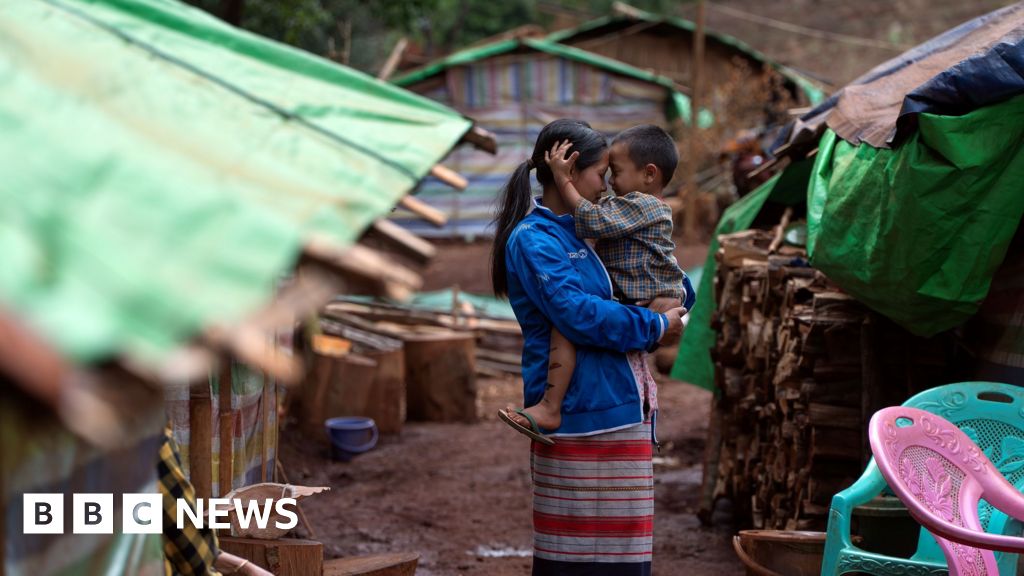Myanmar's Military Ceasefire Violated Despite Earthquake Tragedy

Days after a devastating 7.7-magnitude earthquake struck Myanmar at the end of March, resulting in the tragic loss of over 3,700 lives, the ruling military junta announced a ceasefire. Despite this promise of peace amid chaos, reports indicate that the ceasefire has been repeatedly violated, exposing the grim reality on the ground.
During a ten-day visit to the rebel-held regions of the eastern Karenni state in mid-April, I witnessed firsthand the ongoing aggression by the junta, despite their claims of a cessation in military operations. Daily violations were evident, including relentless rocket and mortar attacks that not only endangered the lives of resistance fighters but also targeted innocent civilians. One poignant account involves Khala, a 45-year-old father, who was killed by a military airstrike in what should have been a safe haven for his family. His wife, Mala, recounted how they felt compelled to return to their home village of Pekin Coco after the ceasefire was announced. However, upon their arrival, they discovered their village was largely abandoned and in ruins, the result of extensive fighting that had forced most residents into safer agricultural areas.
As the young family attempted to leave with their belongings, they were caught in the crossfire of military shelling. Mala recalled the harrowing moment: We were all at the front of the house. Then, shells landed near us. We hid at the back of the house. But he [Khala] stayed where he was. The artillery shell landed and exploded near him. He died in the place where he thought he was safe. Her words were laced with grief as she reflected on the loss of her husband, whom she described as a good man.
Tragically, the violence did not cease there. Later that same day, military aircraft targeted another home on the same street, resulting in the deaths of four additional men. Malas heartbreak was palpable as she declared, I hate them. They always attack people without reason. I don't feel safe here. Jet fighters are flying over the sky often but there is no place to hide. At just 31 years old and seven months pregnant, Mala found herself back in a displaced persons camp, facing the unbearable grief of losing her partner while trying to ensure the safety of her young son, Zoe, who longed for his father.
The ongoing civil conflict in Myanmar, which predated the earthquake, has left a deep scar on the nation. The country has been enduring a brutal civil war, catalyzed by decades of military control and oppression. Ethnic groups and a new generation of insurgents have risen in opposition, bringing the military dictatorship to a critical juncture. Reports indicate that nearly two-thirds of Myanmar is now under the control of resistance forces, contributing to the staggering death toll that has claimed tens of thousands of lives since the coup in February 2021. Prior to the earthquake, approximately 2.5 million people were already displaced, and the UN now estimates that an additional two million have been thrust into dire need as a result of the disaster.
Interestingly, Karenni state, which is situated far from the earthquake's epicenter, has witnessed significant turmoil. While its dense jungles offer a certain level of protection to opponents of the military regime, accessibility remains a significant challenge, with poor road conditions rendering many areas vulnerable to military attacks. On the day of the quake, it was reported that there were no immediate casualties in Karenni, yet local hospitals quickly filled with patients suffering from serious spinal and crush injuries. Among the strange aftermath of the quake was a massive sinkhole, approximately 30 meters (100 feet) deep, that appeared in the surrounding forest. Local residents initially mistook the sound of the ground collapsing for another airstrike, highlighting the pervasive fear that permeates their daily existence.
The United Nations has publicly condemned the military for its continued attacks and has called for an end to hostilities, even in light of the ceasefire. However, the ruling State Administration Council has remained silent on the allegations of ceasefire violations, claiming that it, too, is under attack from resistance groups. Each side in the conflict has maintained the right to respond to any perceived aggression, leading to an ongoing cycle of violence.
During my time in Mobeye, Karenni, I encountered Stefano, a 23-year-old fighter engaged in the struggle against military rule. Leading a platoon with the Karenni Nationalities Defence Force (KNDF), he emphasized the futility of the juntas ceasefire, referring to it as a joke. He detailed how, despite the ceasefire declaration, the military continued to launch assaults using various means, including drone strikes and heavy artillery. They usually attack with drones and heavy artillery on this side. When it rains, they advance by taking advantage of the weather, he explained, underscoring the chaotic and unpredictable nature of their conflict.
Just a day after my conversation with Stefano, the military escalated its offensives with heavy weaponry and a substantial number of troops, targeting rebel positions. As we approached the front lines, the sounds of small arms fire and mortar explosions filled the air, and the ground bore the marks of new drone strikes. Tragically, the militarys aggression did not solely target the resistance; their artillery also struck civilian farmland, resulting in the death of a 60-year-old woman. As we ventured into the fields, we found children playing near the remnants of the attacks, examining bent metal and shrapnel scattered across the ground. Those injured in the strikes were transported to clandestine hospitals hidden deep within the jungles to evade air attacks. In one such facility, I encountered a young fighter receiving treatment for a severe shrapnel wound to his shoulder. The doctor in charge, 32-year-old Thi Ha Tun, recounted how he had treated around a dozen war-related injuries since the ceasefire was announced, with two resistance fighters tragically succumbing to their wounds.




























